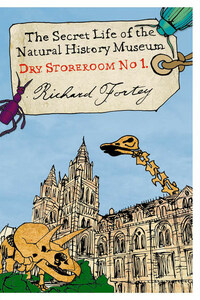I have been enthralled by trilobites for more than thirty years. This book is both my homage to them, and an attempt to convey to others something of the pleasure that their study has given to me. In the process, something of the scientific method may be revealed. My last book was a biography of all life, from bacterium to mankind, in which the trilobites were passed over in a page or two. Now I have the chance to turn the focus the other way and to allow my favourite animals to tell their stories in the detail they deserve. Even so, I am as conscious of what I have had to leave out as of what I have been able to include. History can never be told completely, and three hundred million years of history is bound to be more of a precis than a narrative. I wish to persuade the reader of the excitement of recreating vanished worlds, and of seeing ancient seas through the eyes of the trilobites. This is not an academic study, rather, it is an incitement to discovery.
London October 1999
Out of season, the bar of the Cobweb Inn at Boscastle is everything a pub should be. There is a low, heavily-beamed ceiling hung with antique bottles, and a plain floor which is a jigsaw of flagstones. Photographs of the local womenâs darts team hang on the wall, alongside framed, faded newspaper cuttings which record in print the several virtues of the inn. A log fire gives out rather more heat than is needed. There is no music save the low buzz of rich vernacular; in November, no Londoner ventures to the North Cornwall coast. The Cobweb is a slightly scruffy, comfortable old place, where you can talk if you need to, but if you feel like saying nothing you can just watch the flames in the hearth, and nobody will think you odd if a smile plays on your lips. It takes an effort of will to leave the dark, comfortable, nourishing womb of the inn, and emerge, blinking, into the bright world outside; but leave I must, because I have to find Beeny Cliff before the light fades. It can be dangerous out on the cliffs after nightfall.
Boscastle is tucked into a cleft on the wild northern coast of the long peninsula that completes south-west England, and it is built around a narrow harbour where the River Valency cuts down to the sea. It is an ancient place, where the cosmetics of the tourist tradeâWitchcraft Museum and knick-knack shopsâhave not quite succeeded in smothering a character that was born of slate and hardship. At one time the town comprised almost nothing but inns serving miners and seamen, of which the Cobweb is a survivor, and you can still imagine a dozen different signs advertising their wares all along the crooked street that leads to the haven. The houses are former inns, prettified with features that fail to disguise their boozy origins. The rough local stone gives the buildings their character. Even the Witchcraft Museum is a cottage with an ancient roof that sags crazily under the weight of Cornish slates. On this day the harbour is almost deserted, and I can imagine the place as it must have looked when the poet and novelist Thomas Hardy visited it as a young man, more than a century ago.
I leave the town on the northern side of the harbour where the path zig-zags up the side of the steep valley. There are gorse bushes which even at this time of year cheerfully wave sprigs of yellow pea flowers. Small birds secretively flit across the pathâa wren and some stonechatsâas if inviting me onwards. From up here I can see piers guarding the long, narrow harbour entrance, barriers that were already ancient when the first Elizabeth was on the throne. A cold breeze makes me wish I had put on an extra sweater, but I have luckily caught an interval between showers. Suddenly, I climb high enough to see the sea. This is one of those days when the furthest horizon is obscured in mist, as if the sea went on for ever. It is not stormy weather, but I can hear the growl of the surf smashing against cliffs, which weave in and out to the south, one after another, sheer to the sea. A white surf-line marks the junction:
With its long sea lashings
And cliff side clashings
as Hardy described this coast. The cliffs are dark, almost black, while the sea is strangely heavy, wrinkled like a pachyderm, so that only the lazily shifting white line of breakers serves to animate the prospect. The town in its secret valley has quite slipped from view; the solitude is absolute. I shelter from the breeze behind a wall, which is overgrown with rounded tussocks of sea campion and thrift. It is constructed mostly from blocks of slate; curiously, the slate slabs are placed vertically, so that they look like books set on their edges, pages towards you. I am accustomed to different, horizontally-built stone walls around Oxford. The pattern is broken by occasional piers incorporating angular blocks of white, coarse-looking vein quartz. The artisans who built these walls knew their rocks. Slates stacked vertical will let the rainwater (and there is plenty in Cornwall) drain rapidly away, parallel to the way the rock naturally splits. Rubbly quartz is indifferent to all weathers and makes for obstinate pillars. Both rock types are now decorated with a leafy, frilly form of green lichen, which softens every stony outline in such a damp climate.













